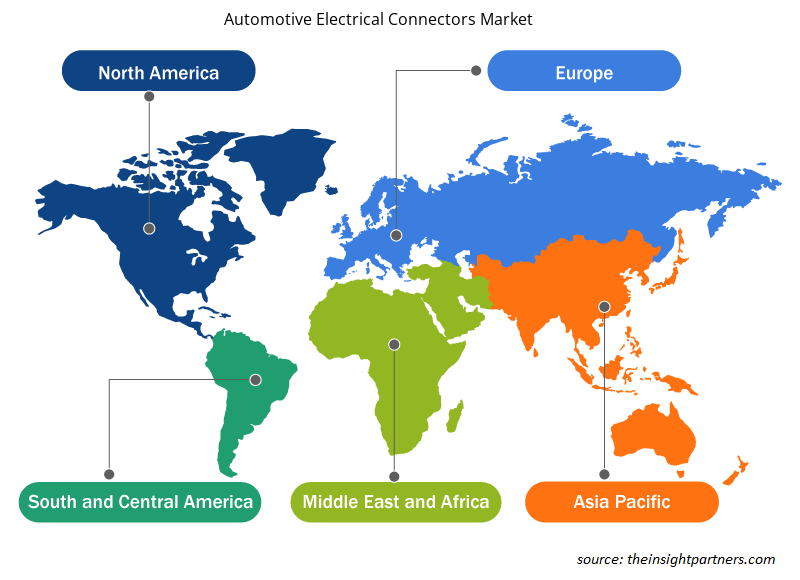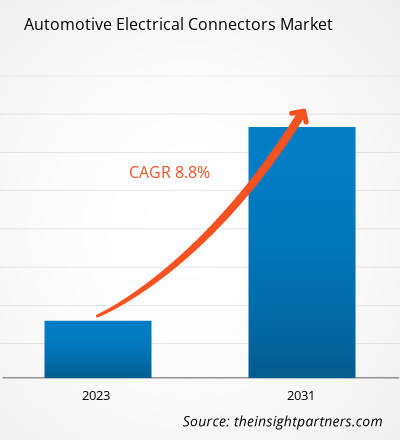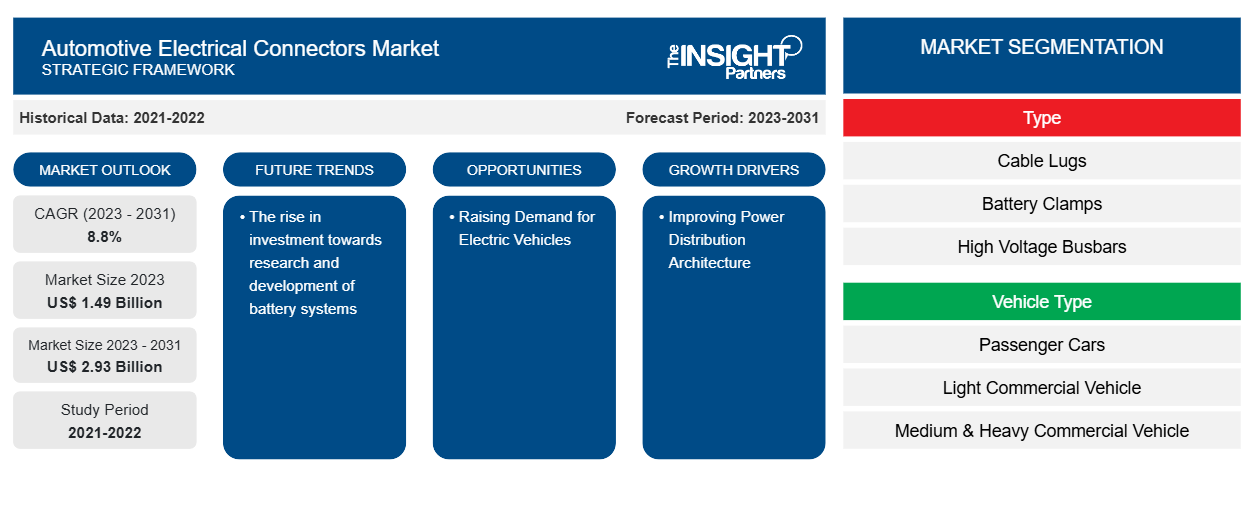Der Markt für elektrische Steckverbinder für Kraftfahrzeuge soll von 1,49 Milliarden US-Dollar im Jahr 2023 auf 2,93 Milliarden US-Dollar im Jahr 2031 anwachsen. Der Markt soll zwischen 2023 und 2031 mit einer durchschnittlichen jährlichen Wachstumsrate von 8,8 % wachsen. Der Anstieg der Investitionen in die Forschung und Entwicklung von Batteriesystemen dürfte weiterhin ein wichtiger Trend auf dem Markt bleiben.
Marktanalyse für elektrische Steckverbinder für Kraftfahrzeuge
Eine weltweit zunehmende Elektrifizierung der Verkehrsinfrastruktur und von Fahrzeugen wird voraussichtlich die Nachfrage nach elektrischen Steckverbindern für Kraftfahrzeuge ankurbeln, was wiederum das Marktwachstum in den kommenden Jahren ankurbeln dürfte. Darüber hinaus wird erwartet, dass die Verbesserung der Stromverteilungsarchitektur das Marktwachstum für elektrische Steckverbinder für Kraftfahrzeuge im Prognosezeitraum ankurbeln wird. Darüber hinaus wird erwartet, dass die steigende Nachfrage nach Elektrofahrzeugen und Hybridelektrofahrzeugen von 2023 bis 2031 Chancen für die wichtigsten Unternehmen schafft, die auf dem Markt tätig sind.
Marktübersicht für elektrische Steckverbinder für Kraftfahrzeuge
Das Ökosystem des Marktes für elektrische Steckverbinder für Kraftfahrzeuge besteht aus den folgenden Interessengruppen: Rohstofflieferanten, Steckverbinderhersteller, OEMs und Endverbraucher. Die Rohstofflieferanten liefern das Material zum Bau der elektrischen Steckverbinder für Kraftfahrzeuge, beispielsweise Kupfer, Nickel und Silber. Auch kleine Komponenten reichen von einer kleinen Schraube bis zu einem Gehäuse. Die Steckverbinderhersteller führen verschiedene Prozesse durch, beispielsweise Design, Montage und Produktion, um Rohstoffe in fertige Produkte umzuwandeln. INTERCABLE srl, Amphenol Corporation und Rogers Corporation sind unter anderem führende Hersteller von elektrischen Steckverbindern für Kraftfahrzeuge.
Die Unternehmen bieten Fahrzeugherstellern und Aftermarket-Kunden verschiedene Produkttypen wie Kabelschuhe, Hochspannungssammelschienen, Batterieklemmen und Sicherungskästen an. Diese elektrischen Steckverbinder werden von OEMs wie Volkswagen, Toyota, Volvo, Daimler und Ford Motor Company beschafft. Die Endverbraucher sind eine große Anzahl von Kunden, von Käufern von Privatfahrzeugen bis hin zu Flottenbetreibern. Die Hersteller von elektrischen Steckverbindern für Kraftfahrzeuge bieten ihren Kunden auch einen Kundendienst für den Austausch der Fahrzeugsteckverbinder an.
Passen Sie diesen Bericht Ihren Anforderungen an
Sie erhalten kostenlose Anpassungen an jedem Bericht, einschließlich Teilen dieses Berichts oder einer Analyse auf Länderebene, eines Excel-Datenpakets sowie tolle Angebote und Rabatte für Start-ups und Universitäten.
-
Holen Sie sich die wichtigsten Markttrends aus diesem Bericht.Dieses KOSTENLOSE Beispiel umfasst eine Datenanalyse von Markttrends bis hin zu Schätzungen und Prognosen.
Markttreiber und Chancen für elektrische Steckverbinder für Kraftfahrzeuge
Verbesserung der Stromverteilungsarchitektur zur Förderung des Marktes
Industrienationen wie die USA, Großbritannien und Deutschland setzen verstärkt auf Elektrofahrzeuge. Unternehmen in diesen Industrieländern entwickeln Hochspannungsbatterietechnologien, um die Leistung und Speicherkapazität der Fahrzeuge zu verbessern. Daher steigt die Nachfrage nach unterstützenden Steckverbindern für effiziente Stromverbindungen, was das Marktwachstum ankurbelt. Neue Elektroprodukte wie Sicherungskästen, Kabelschuhe und Sammelschienen werden entwickelt, um die Stromverteilung zu verbessern. Sicherungskästen sind erforderlich, um eine effiziente Stromverteilung aufrechtzuerhalten, was die Nachfrage nach Sicherungskästen steigert und damit den Markt antreibt.
So erhielt Eaton, das Geschäftssegment eMobility, im April 2021 einen Auftrag zur Entwicklung von Sicherungen und Stromverteilern (PDUs) der Bussmann-Serie für Fahrzeughersteller. Die PDUs, auch Sicherungskästen genannt, werden für ein neues batteriebetriebenes Elektrofahrzeug (BEV) für leichte Nutzfahrzeuge eingesetzt. Sicherungskästen übertragen Batteriestrom an Fahrzeugkomponenten und haben eine Sicherheitsfunktion, indem sie Stromkreisschutz bieten. Die sich ändernde Stromverteilungsarchitektur schafft die Nachfrage nach neuen Sicherungskästen und fördert so das Marktwachstum.
Steigende Nachfrage nach Elektrofahrzeugen
Die Regierungen verschiedener Länder erlassen spezifische Vorschriften zur Kontrolle der Emissionen von Diesel- und Benzinfahrzeugen. Aufgrund dieser Norm verlagern die Fahrzeughersteller ihren Schwerpunkt daher auf die Produktion von Plug-in-Hybridfahrzeugen, Hybridfahrzeugen und batteriebetriebenen Elektrofahrzeugen. Fahrzeugabgase sind weltweit die Hauptverschmutzungsquelle, und Fahrzeuge wie Autos, Lastwagen und Busse tragen am meisten dazu bei. Die hohe Effizienz von Elektrofahrzeugen (EVs) im Vergleich zu herkömmlichen Diesel- und Erdgasfahrzeugen ist einer der Schlüsselfaktoren, die den Markt für elektrische Steckverbinder für Kraftfahrzeuge im analysierten Zeitraum voraussichtlich ankurbeln werden. Darüber hinaus bieten die Regierungen verschiedener Länder wie der USA, Großbritanniens und Deutschlands Subventionsprogramme an, um die Nutzung von Elektrofahrzeugen zu fördern. Daher wird erwartet, dass die steigende Nachfrage nach Elektrofahrzeugen von 2023 bis 2031 Chancen für die wichtigsten Unternehmen auf dem Markt für elektrische Steckverbinder für Kraftfahrzeuge schaffen wird.
Segmentierungsanalyse des Marktberichts für elektrische Steckverbinder für Kraftfahrzeuge
Wichtige Segmente, die zur Ableitung der Marktanalyse für elektrische Steckverbinder im Automobilbereich beigetragen haben, sind Typ, Fahrzeugtyp und Antriebsstrangtyp
- Nach Typ ist der Markt für elektrische Steckverbinder für Kraftfahrzeuge in Kabelschuhe, Batterieklemmen, Hochspannungssammelschienen und Sicherungskästen unterteilt. Das Segment der Sicherungskästen hatte im Jahr 2023 den größten Marktanteil.
- Nach Fahrzeugtyp ist der Markt in Personenkraftwagen, leichte Nutzfahrzeuge (LCV) sowie mittlere und schwere Nutzfahrzeuge (M&HCV) segmentiert. Das Pkw-Segment hatte im Jahr 2023 den größten Marktanteil.
- Nach Antriebsart ist der Markt in Verbrennungsmotoren (ICE), Elektrofahrzeuge (EV), Plug-in-Hybridfahrzeuge (PHEV) und Hybridfahrzeuge (HEV) unterteilt. Das Segment der Verbrennungsmotoren hatte im Jahr 2023 einen erheblichen Marktanteil.
Marktanteilsanalyse für elektrische Steckverbinder für Kraftfahrzeuge nach geografischer Lage
Der geografische Umfang des Marktberichts für elektrische Steckverbinder für Kraftfahrzeuge ist hauptsächlich in fünf Regionen unterteilt: Nordamerika, Asien-Pazifik, Europa, Naher Osten und Afrika sowie Süd- und Mittelamerika.
Der Umfang des Marktberichts für elektrische Steckverbinder für Kraftfahrzeuge umfasst Nordamerika (USA, Kanada und Mexiko), Europa (Spanien, Großbritannien, Deutschland, Frankreich, Italien und den Rest Europas), den asiatisch-pazifischen Raum (Südkorea, China, Indien, Japan, Australien und den Rest des asiatisch-pazifischen Raums), den Nahen Osten und Afrika (Südafrika, Saudi-Arabien, die Vereinigten Arabischen Emirate und den Rest des Nahen Ostens und Afrikas) sowie Südamerika (Brasilien, Argentinien und den Rest Südamerikas). In Bezug auf den Umsatz dominierte der asiatisch-pazifische Raum im Jahr 2023 den Marktanteil für elektrische Steckverbinder für Kraftfahrzeuge. Europa ist der zweitgrößte Beitragszahler zum globalen Markt für elektrische Steckverbinder für Kraftfahrzeuge, gefolgt von Nordamerika.
Regionale Einblicke in den Markt für elektrische Steckverbinder für Kraftfahrzeuge
Die regionalen Trends und Faktoren, die den Markt für elektrische Steckverbinder für Kraftfahrzeuge im gesamten Prognosezeitraum beeinflussen, wurden von den Analysten von Insight Partners ausführlich erläutert. In diesem Abschnitt werden auch die Marktsegmente und die Geografie für elektrische Steckverbinder für Kraftfahrzeuge in Nordamerika, Europa, im asiatisch-pazifischen Raum, im Nahen Osten und Afrika sowie in Süd- und Mittelamerika erörtert.

- Erhalten Sie regionale Daten zum Markt für elektrische Steckverbinder für Kraftfahrzeuge
Umfang des Marktberichts für elektrische Steckverbinder für Kraftfahrzeuge
| Berichtsattribut | Details |
|---|---|
| Marktgröße im Jahr 2023 | 1,49 Milliarden US-Dollar |
| Marktgröße bis 2031 | 2,93 Milliarden US-Dollar |
| Globale CAGR (2023 - 2031) | 8,8 % |
| Historische Daten | 2021-2022 |
| Prognosezeitraum | 2023–2031 |
| Abgedeckte Segmente |
Nach Typ
|
| Abgedeckte Regionen und Länder |
Nordamerika
|
| Marktführer und wichtige Unternehmensprofile |
|
Marktteilnehmerdichte für elektrische Steckverbinder für Kraftfahrzeuge: Auswirkungen auf die Geschäftsdynamik verstehen
Der Markt für elektrische Steckverbinder für Kraftfahrzeuge wächst rasant. Dies wird durch die steigende Nachfrage der Endnutzer aufgrund von Faktoren wie sich entwickelnden Verbraucherpräferenzen, technologischen Fortschritten und einem größeren Bewusstsein für die Vorteile des Produkts vorangetrieben. Mit der steigenden Nachfrage erweitern Unternehmen ihr Angebot, entwickeln Innovationen, um die Bedürfnisse der Verbraucher zu erfüllen, und nutzen neue Trends, was das Marktwachstum weiter ankurbelt.
Die Marktteilnehmerdichte bezieht sich auf die Verteilung der Firmen oder Unternehmen, die in einem bestimmten Markt oder einer bestimmten Branche tätig sind. Sie gibt an, wie viele Wettbewerber (Marktteilnehmer) in einem bestimmten Marktraum im Verhältnis zu seiner Größe oder seinem gesamten Marktwert präsent sind.
Die wichtigsten auf dem Markt für elektrische Steckverbinder für Kraftfahrzeuge tätigen Unternehmen sind:
- INTERCABLE Srl
- Connor-Fertigung
- Amphenol Corporation
- Emerson Electric Co.
- Rogers Corporation
- Molex
Haftungsausschluss : Die oben aufgeführten Unternehmen sind nicht in einer bestimmten Reihenfolge aufgeführt.

- Überblick über die wichtigsten Akteure auf dem Markt für elektrische Steckverbinder für Kraftfahrzeuge
Marktnachrichten und aktuelle Entwicklungen zu elektrischen Steckverbindern für Kraftfahrzeuge
Der Markt für elektrische Steckverbinder für Kraftfahrzeuge wird durch die Erfassung qualitativer und quantitativer Daten nach Primär- und Sekundärforschung bewertet, die wichtige Unternehmensveröffentlichungen, Verbandsdaten und Datenbanken umfasst. Nachfolgend sind einige der Entwicklungen auf dem Markt für elektrische Steckverbinder für Kraftfahrzeuge aufgeführt:
- ENNOVI (Unternehmen für Mobilitätselektrifizierung) hat die Automotive-Ethernet-Steckverbinderlösung ENNOVI-Net mit Presspassungsverbindungen eingeführt. Diese Produkteinführung hat das Produktportfolio des Unternehmens in diesem Markt erweitert. (Quelle: ENNOVI, Pressemitteilung, März 2024)
- ETCO hat Steckverbinder für Elektrofahrzeuge eingeführt. Dieser neue Steckverbinder hält starken Vibrationen, Stößen und extremen Temperaturen stand. Diese Steckverbinder werden zwischen den Batteriepacks und den Batteriemanagementsystemen verwendet. (Quelle: ETCO, Pressemitteilung, Mai 2022)
Marktbericht zu elektrischen Steckverbindern für Kraftfahrzeuge – Umfang und Ergebnisse
Der Bericht „Marktgröße und Prognose für elektrische Steckverbinder für Kraftfahrzeuge (2021–2031)“ bietet eine detaillierte Analyse des Marktes, die die folgenden Bereiche abdeckt:
- Marktgröße und Prognose für elektrische Steckverbinder für Kraftfahrzeuge auf globaler, regionaler und Länderebene für alle wichtigen Marktsegmente, die im Rahmen des Berichts abgedeckt sind
- Markttrends für elektrische Steckverbinder im Automobilbereich sowie Marktdynamik wie Treiber, Einschränkungen und wichtige Chancen
- Detaillierte PEST- und SWOT-Analyse
- Marktanalyse für elektrische Steckverbinder für Kraftfahrzeuge mit Blick auf wichtige Markttrends, globale und regionale Rahmenbedingungen, wichtige Akteure, Vorschriften und aktuelle Marktentwicklungen
- Branchenlandschaft und Wettbewerbsanalyse, die die Marktkonzentration, Heatmap-Analyse, prominente Akteure und aktuelle Entwicklungen auf dem Markt für elektrische Steckverbinder für Kraftfahrzeuge umfasst
- Detaillierte Firmenprofile
- Historische Analyse (2 Jahre), Basisjahr, Prognose (7 Jahre) mit CAGR
- PEST- und SWOT-Analyse
- Marktgröße Wert/Volumen – Global, Regional, Land
- Branchen- und Wettbewerbslandschaft
- Excel-Datensatz
Aktuelle Berichte
Erfahrungsberichte
Grund zum Kauf
- Fundierte Entscheidungsfindung
- Marktdynamik verstehen
- Wettbewerbsanalyse
- Kundeneinblicke
- Marktprognosen
- Risikominimierung
- Strategische Planung
- Investitionsbegründung
- Identifizierung neuer Märkte
- Verbesserung von Marketingstrategien
- Steigerung der Betriebseffizienz
- Anpassung an regulatorische Trends























 Kostenlose Probe anfordern für - Markt für elektrische Steckverbinder für Kraftfahrzeuge
Kostenlose Probe anfordern für - Markt für elektrische Steckverbinder für Kraftfahrzeuge